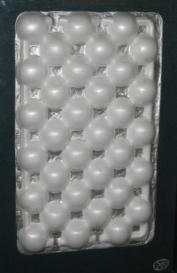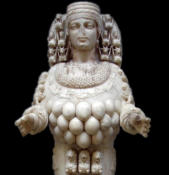



All texts copyright Richard Shillitoe
ephesian diana
1967
Silver painted polystyrene fruit tray mounted on hardboard and in a box frame.
19 x 11¾in. (48.3 x 30cm.)
Monogrammed and dated verso.
Provenance
Bonhams, 20 Sept. 1995, lot 566, as 1963.
Rosebery’s, 27 Nov. 2001, lot 176, ill. b/w, as 24⅜ x 16½in.
Christie’s, 4 Dec. 2002, lot 489, with Ripples (1971).
Bonhams, 13 July 2004, lot 42.
Red Raven Arts, London.
Exhibited
Penzance, Newlyn Gallery, 1967, no. 25.
Penzance, Newlyn Gallery, 1969, (Autumn), no. 78.
Bristol, The Arts Centre, 1970, no. 38.
Rounded depressions for containing fruit suggest the multiple breasts which are themselves containers for
nourishment. Silver is the colour of the moon and the colour of the Goddess.
Diana was the tutelary goddess of the Ephesians. Her Temple at Ephesus was one
of the seven ancient wonders of the world. Diana (known as Artemis to the
Greeks) wore the Tower of Babel as a crown on her head. With her multiple
breasts, she represented fertility and sexuality. She is a divine mother figure.
An alternative theory has it that the breasts are really a cluster of bee eggs. The
bee was the symbol of Ephesus, appearing on its coinage and may have been
regarded as sacred. The priestesses of Artemis were known as worker bees.
Breast or egg, the life-giving associations remain the same.



















